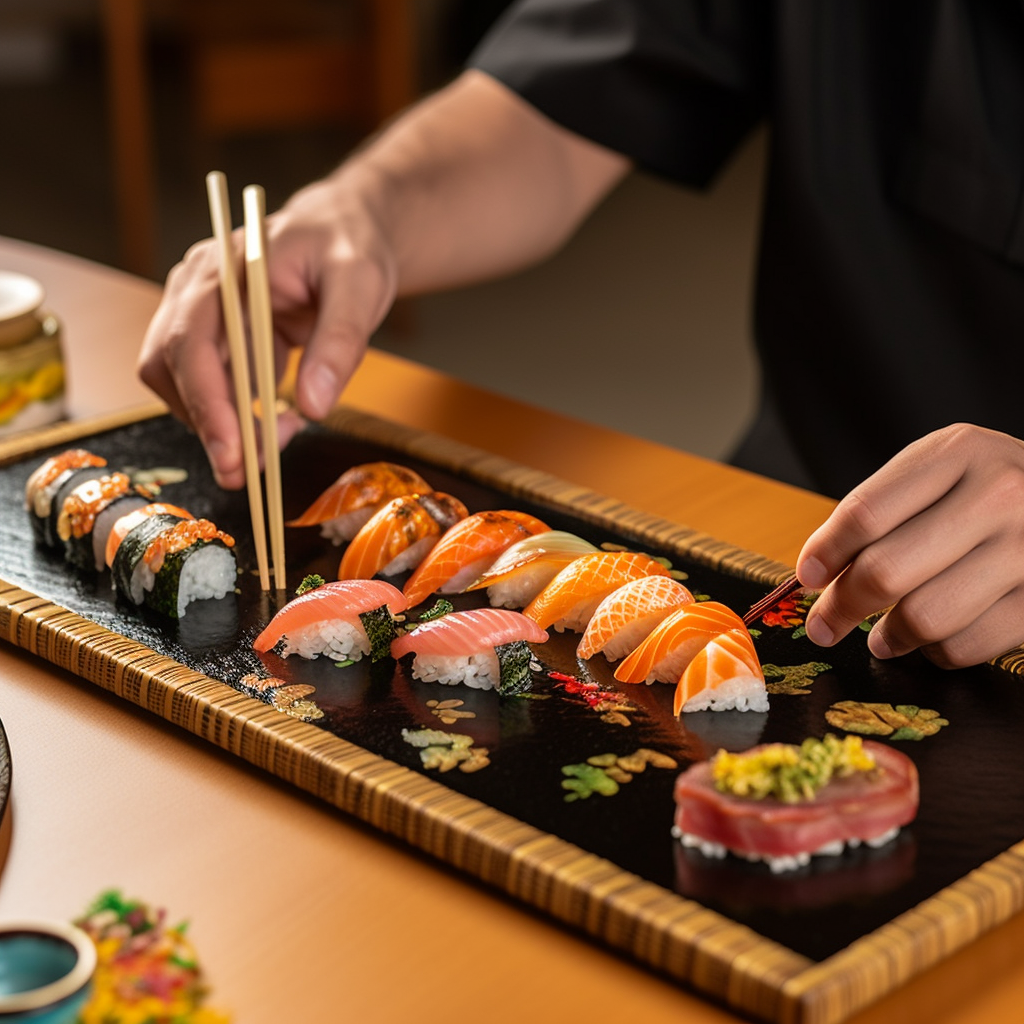Greetings, kindred spirits! Percival Q. Higginbottom here, ever eager to share another of my culinary escapades. Today, we shall traverse the figurative seas to the Land of the Rising Sun, where I partook in the intricate dance of tradition and creativity – the creation of Sushi.
From my first visit to Japan, I was captivated by sushi’s elegance. On the surface, it appears simple – a little fish atop a compact mound of rice. However, this is akin to calling a grand symphony merely a combination of sounds. Sushi, my dear friends, is a symphony of the senses.
The journey begins with the rice, the heart of sushi. The term sushi itself stems from an old term meaning “sour-tasting”, reflecting the original technique of fermenting rice. Today, sushi rice is meticulously seasoned with a blend of vinegar, sugar, and salt, leading to its distinct and delightful tang.
Then, the orchestra of seafood makes its entrance. From the iridescent scales of fresh tuna to the delicate hues of shrimp, each element is selected with an eye for aesthetics and an understanding of seasonal bounty. This is where the artistry of the sushi chef, or itamae, shines.
An itamae’s journey is one of years, even decades, of study and dedication. From perfecting the slice of the nigiri to presenting the sushi with a humble elegance, it is an art form passed down through generations. During my visit, I had the honor of learning from an itamae who, with a graceful flick of his Yanagiba knife, transformed simple ingredients into an edible masterpiece.
Then comes the consumption of sushi. It’s an experience that honors the transient beauty of the dish. From the moment it’s served, you’re encouraged to partake immediately, appreciating the delicate balance of flavors – the briny taste of the sea mingling with the subtle tang of the rice.
Sushi is also a testament to Japan’s reverence for nature. It exemplifies the concept of “ikigai,” where joy, mission, vocation, and profession intersect, manifesting in a cuisine that celebrates the seasons and the ocean’s bounty.
As I savored the sushi, I was struck by the silence in the room – a silence punctuated by appreciative murmurs and the clink of chopsticks. It seemed to encapsulate the essence of sushi: a pause in time, a moment to appreciate the harmony of nature and craftsmanship.
So there you have it, dear friends – a peek into the soulful symphony of sushi. It’s not merely a dish; it’s a celebration of tradition, an art form, and a testament to a culture that finds beauty in simplicity and perfection in detail. Until our next culinary adventure, may your plates be full and your spirits even fuller.
Tallyho,
Percival Q. Higginbottom

Suggested Further Reading:
- The History of Sushi – A comprehensive look at the evolution of sushi from its earliest incarnations to the global phenomenon it is today.
- The Role of the Itamae – This article delves into the journey of becoming an itamae, from apprentice to master sushi chef.
- Understanding Ikigai – Learn more about the philosophy of ikigai, a central theme in Japanese culture and cuisine.





6 thoughts on “The Soulful Symphony of Sushi: A Dive into the Japanese Art Form”
I don’t think the title of your article matches the content lol. Just kidding, mainly because I had some doubts after reading the article.
I don’t think the title of your article matches the content lol. Just kidding, mainly because I had some doubts after reading the article.
Your point of view caught my eye and was very interesting. Thanks. I have a question for you.
I don’t think the title of your article matches the content lol. Just kidding, mainly because I had some doubts after reading the article.
Just wanted to throw my two cents in about bahsegel865. Reliable, no weird glitches, and withdrawals are reasonably quick. Happy customer here.
77win, heard good things. Giving it a shot tonight! Trying out some of the live casino games. Wish me luck, fellas! Let me know if you have any tips!. 77win